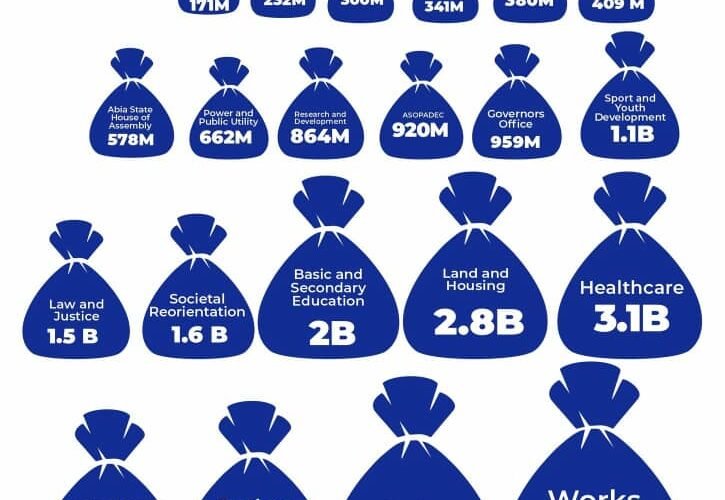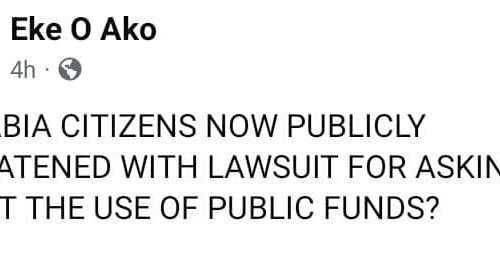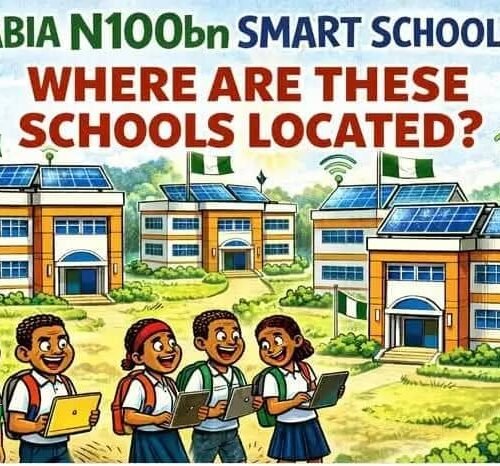Abia’s Q3 2025 Financial Report: Facts, Context and the Politics of Manufactured Doubt — A Response to Obinna Oriaku
Public commentary on Abia State’s finances is healthy for democracy, but it becomes dangerous when it is anchored on selective interpretation, exaggerated arithmetic, and an unfortunate attempt to weaponize public misunderstanding. Obinna Oriaku’s critique of Abia’s Q3 2025 Financial Report is a vivid example of how numbers can be stretched to create suspicion where none exists, and how nostalgia for opacity can be disguised as patriotism. His concerns sound weighty until they are placed beside verifiable data, constitutional accounting rules and the historical context of Abia’s fiscal evolution.
Understanding the Revenue Numbers
Oriaku’s foundational argument rests on the claim that Abia received “₦38 billion monthly” in Q2 2025. This figure collapses instantly under scrutiny. The Federal Ministry of Finance FAAC bulletin shows that Abia’s statutory FAAC allocation for Q2 was approximately ₦33.3 billion in total—not monthly. The elevated Q2 figure resulted from one-off, non-recurring inflows including exchange-gain spikes, PAYE reconciliations and refund adjustments triggered by the FX harmonisation policy. These temporary infusions affected every state in the federation. To label them as “monthly FAAC” is not only incorrect but misleading. Abia’s true monthly liquidity, when VAT and IGR are included, averages between ₦8 billion and ₦10 billion. This is what allows for sustainable planning. Anything beyond this is political arithmetic.
On the Question of Local Government Allocations
The attempt to fuse LGA allocations with state income to create the illusion of “₦40 billion monthly inflows” betrays a disregard for the Constitution. Local Government funds are not state revenue. They are paid into the State Joint Local Government Account and appropriated through LGA legislative processes. SFTAS rightly excludes them because they are distinct fiscal entities. Any former Commissioner of Finance understands this. Conflating both streams to manufacture a crisis is either ignorance or deliberate obfuscation.
Project Visibility and Engineering Reality
Oriaku’s commentary on project visibility is built on a false equivalence. The Port Harcourt Road reconstruction is not a “patchwork” programme but a complete geotechnical rebuild validated in a Julius Berger televised assessment. With collapsed drainage, hydrocarbon-contaminated soil and no structural base, the road was beyond surface repair. Comparing this to the renovation of Enugu Presidential Hotel or Owerri Concord Hotel—projects that are largely cosmetic—is a flawed attempt to equate engineering projects belonging to entirely different classes. A dilapidated industrial artery and a hotel refurbishment are not comparable by any economic, engineering or procurement standard.
The Misrepresentation of Sectoral Expenditure*
The most unfortunate claim in Oriaku’s piece is the assertion that Abia has spent “₦82 billion on schools.” There is no such figure in any official report. The total education expenditure from 2024 to Q3 2025 is approximately ₦34.7 billion, covering teacher salaries, UBEC counterpart funding, classroom upgrades, ICT integration, school rehabilitation and Smart School implementation. The inflated number he quotes is sourced not from Abia’s accounts but from politically driven WhatsApp broadcasts. Responsible public discourse must rest on documented evidence, not street arithmetic.
On the Reorganisation of Budget Sub-Heads
The suggestion that “Research and Development” is a disguised security vote ignores the modernisation of public finance structures across Nigeria. Lagos, Kaduna, Edo and Kwara all use consolidated governance and innovation sub-heads when merging ICT systems, monitoring mechanisms, evaluation platforms and performance dashboards. Abia has replaced outdated fragmentation with a system that reflects 21st-century governance. This is reform, not concealment.
Agriculture, Counterpart Funding and Misplaced Accusations
Oriaku’s criticism of agricultural allocations omits the fact that Abia currently operates multiple external agricultural programmes—IFAD VCDP II, FADAMA CARES extensions and AfDB Agro-processing Zone preparations—that do not appear as “state agricultural expenditure” because they are tracked separately under capital-external classifications. He knows this from experience, yet chooses not to disclose it, relying instead on assumptions that exploit citizens’ unfamiliarity with multilateral funding cycles.
The AfDB Loan and Financial Integrity

Perhaps the most revealing line in his analysis is the suggestion that Abia might “hide” an AfDB facility. Multilateral loans are disbursed in tranches, audited independently, monitored by international procurement officers and published with global visibility. The entire concept of “hiding” an AfDB loan is impossible. The claim displays either an astonishing gap in understanding or an attempt to provoke alarm through unfounded insinuations.
On Public Beautification and Cost Exaggerations
The portrayal of roundabout fountains as evidence of waste leans heavily on fabricated fuel-use calculations. The fountains run on hybrid systems, scheduled operations and low-energy pumps. Even under inflated diesel assumptions, their operating cost is nowhere near the dramatic numbers presented. Beautification is not a substitute for water supply, but neither is it evidence of fiscal irresponsibility. It is a normal component of urban renewal.
Historical Context and the Question of Integrity
Oriaku’s critique would carry more moral weight if he acknowledged the condition of Abia’s finances during his own tenure. Between 2015 and 2023, salary arrears accumulated to between 36 and 46 months across institutions; pensions were unpaid; SFTAS transparency audits were repeatedly failed; procurement processes were opaque; road development crawled; and revenue systems decayed. Today, those arrears have been cleared, salaries are paid monthly, procurement is digitised, debt reports are published and revenue is automated. These are measurable reforms, not propaganda.
Conclusion: Transparency Has Finally Become a System, Not a Slogan
Abia is not perfect, and no government is above scrutiny. But criticism must be grounded in truth, not theatrics. The Q3 2025 report follows World Bank-compliant SFTAS guidelines, separates LG allocations as required by the Constitution, and reflects a level of openness absent in the state for more than two decades. The attempt to manufacture opacity where transparency now thrives reveals more about motive than about governance.
Obinna Oriaku deserves commendation for engaging the public, but he does not deserve immunity from facts. History remembers what was once hidden. The numbers today do not lie—and they no longer belong to the shadows.
AProf Chukwuemeka Ifegwu Eke







